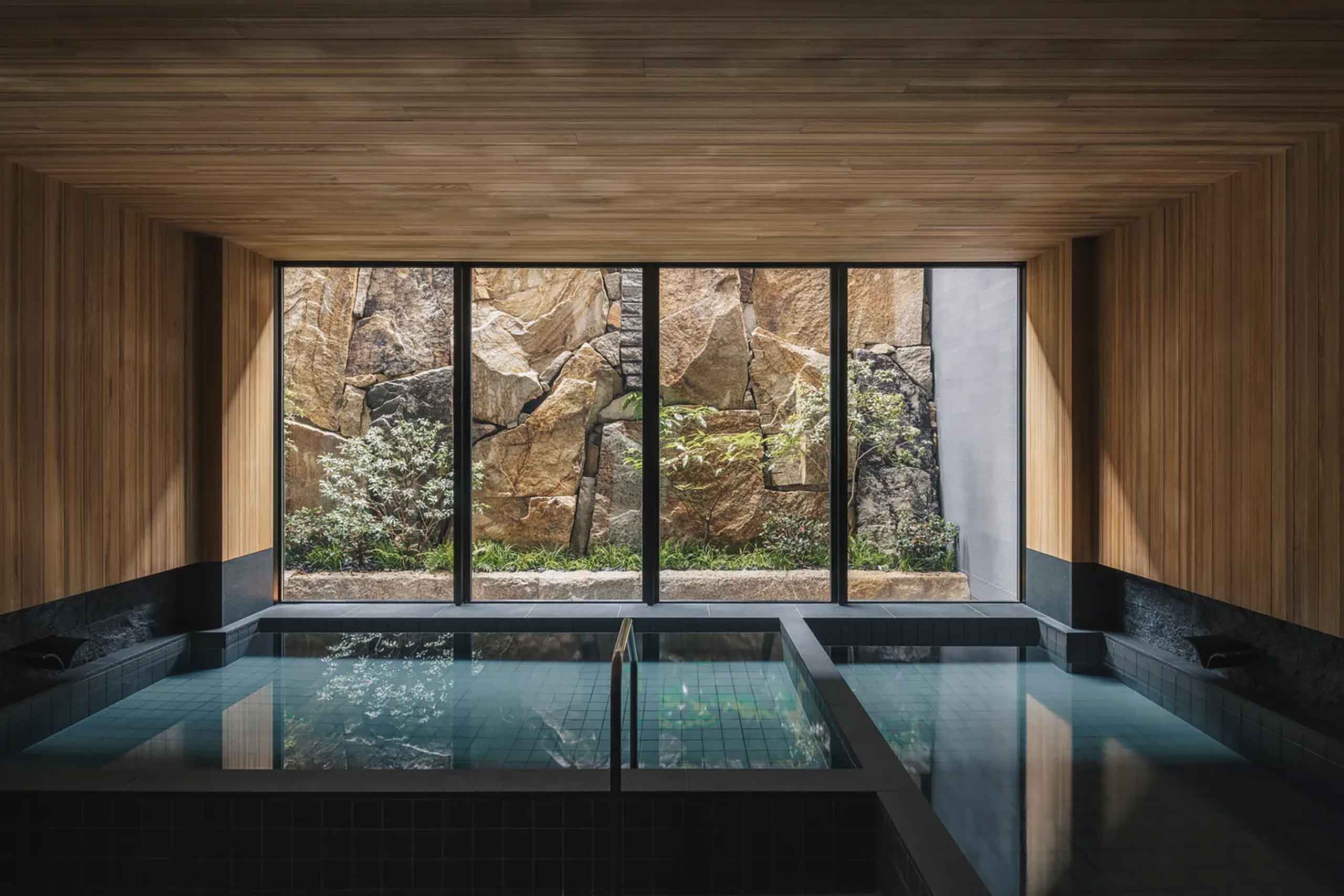The storied Japanese city of Kyoto has a tendency to whisper rather than shout. It’s a city of poetic pauses and ancient alleyways where you’re as likely to bump into a temple priest as you are a very mischievous-looking fox statue. It’s in this hushed splendour that Six Senses Kyoto quietly, surprisingly, unmistakably, stakes its sense of place. And like a well-written haiku, or something right out of a Studio Ghibli movie, the hotel may appear simple on the surface, but there’s a whole, magnificent universe unfolding underneath.
This property felt immediately like the rebellious child in the usually chilled-out Six Senses family. You know the one: not quite like its beachy, jungle-hugging siblings, but rather the city-dwelling, cultured intellectual.
At first glance, it didn’t scream that renowned ‘barefoot luxury’ that the brand is known for. In fact, we wondered if we had come to the right place. We thought we had wandered into an eccentric art museum curated by a whimsical, slightly eccentric Kyoto native with a fondness for foxes and frogs! But after spending several days here, the Six Senses Kyoto gently pulled us into its own orbit. It is, quite simply, a treasure chest of storytelling. And it all began with Japan’s very first one.
Japanese Noblewoman Murasaki Shikibu’s The Tale of Genji, penned in the early 11th century during the Heian period, is widely regarded as the world’s first novel. It tells the story of eponymous Genji, a handsome nobleman (the “Shining Prince,”) and gifted aristocrat whose romantic entanglements – from tender childhood infatuations to complex adult affairs – play out against the refined backdrop of the Heian-period imperial court. It was a time of unprecedented artistic expression, where court ladies wrote poetry on fans and fashion was as layered as the prose.
Beyond its richly wrought love stories, the novel is a sensitive study of impermanence and the subtleties of human emotion (aesthetic concepts such as mono no aware, the poignancy of passing things, suffuse its pages). We see Genji navigate court politics, pursue artistic accomplishment – poetry, music, calligraphy – and contend with the consequences of his own passions. Through more than a thousand chapters of evocative courtly ritual, moonlit gardens and handwritten poetry exchanges, The Tale of Genji offers an intimate portrait of Heian Japan’s pinnacle of elegance – and enduring insights into desire, loss and the constant flow of time.
Six Senses Kyoto takes all of this to heart. The hotel dives deep into the fable. Set in a traditional machiya townhouse layout, with an inner courtyard (a sanctum of calm), the architecture, courtesy of Blink Design Group from Singapore, isn’t about flashy statements, but leans more into elegant story craft. Every beam, every shoji screen, every pebbled path is a plot point.
Entering beyond the key-carded doors of the hotel, we were greeted not with a quintessentially Japanese bow, but with a gaze – from 81 backlit papier-mâché Inari fox masks. Their eyes glowed with mischief and meaning, nodding to the Shinto deity of prosperity. And the foxes weren’t alone. Frogs and rabbits popped up unexpectedly, playing a surrealist game of hide-and-seek through the public spaces. It was delightfully bonkers in a way that only made sense once we had surrendered to the charm.
Our suite here was comfortable, minimalist (of course) and quietly stylish, filled with thoughtful details: a hushed retreat where timeless Japanese craftsmanship meets modern, sustainable luxury. Tatami-style flooring and shōji screens softly filter the light, casting geometric shadows across pared-back wooden furnishings. A low cedar bed draped in organic linens invited languid mornings, while a deep hinoki-wood soaking tub perched by the window offered steam-laden views of the garden’s mossy stones. Natural stone sinks, hand-woven textiles and locally milled ceramics punctuate the neutral palette, each piece telling a story of Kyoto’s artisans. A balcony that spanned the entire length of the space connected us to the property’s garden. We’d say that our room was luxurious, but not flamboyant: a sanctuary of subtlety.
There were other room categories that looked out and opened onto a zen courtyard. Some overlooked a cherry blossom tree that, come spring, transforms the window into a living postcard, so we’re told. Four speciality suites boast their own traditional Japanese gardens.
Back outside at Six Senses Kyoto, down long fox-lined corridors, there was plenty more for us to see and be amazed by. Behind the reception desk, a magnificent piece of art revealed the silhouette of sacred Mount Kurama. It’s composed of 504 Rakuyaki tiles from the local Kiyomizu district, each one a brushstroke in the story. In a meeting space tucked away just off the entrance, we found hundreds of daruma, traditional Japanese round papier-mâché dolls (that always right themselves when tipped) modelled on Bodhidharma, the Buddhist monk who founded Zen.
Then there’s the speakeasy bar, Nine Tails, with its gorgeous cedar wood floor inlaid with subtle paw prints. Here, master bartenders craft each libation with seasonal syrups, house-made cordials and an encyclopaedic array of Japanese spirits – shōchū brightened with local citrus, whisky kissed by oolong smoke and silky plum-wine elixirs that lingered on our tongues. Its mascot, a sly nine-tailed fox, is both brand ambassador and spiritual guardian, grinning with the knowingness of a creature that’s seen it all and still has time to play.
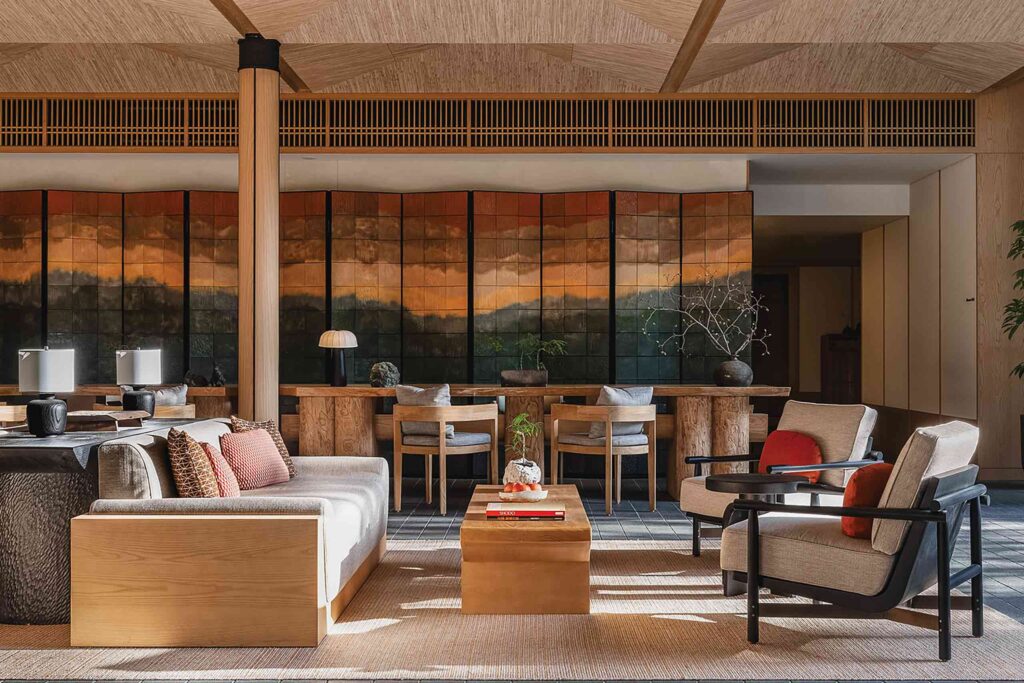
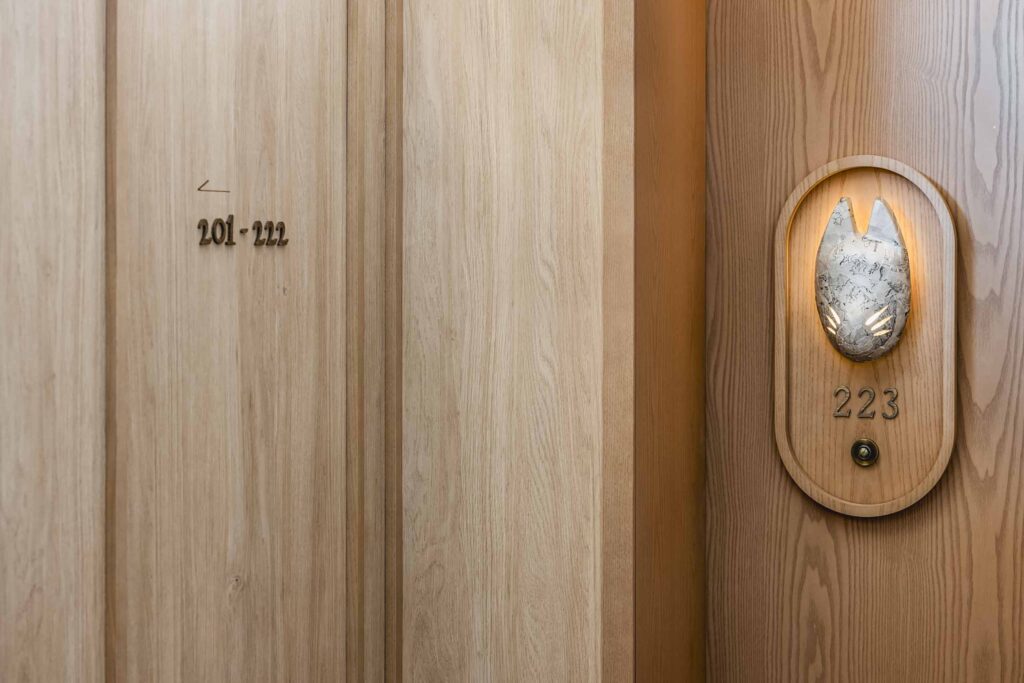
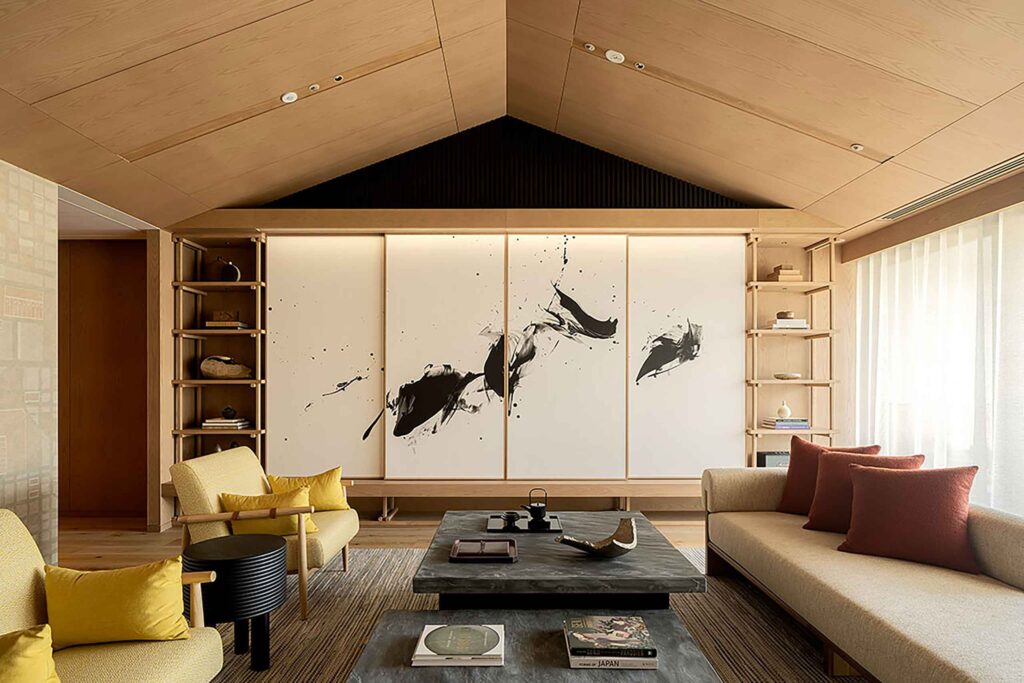

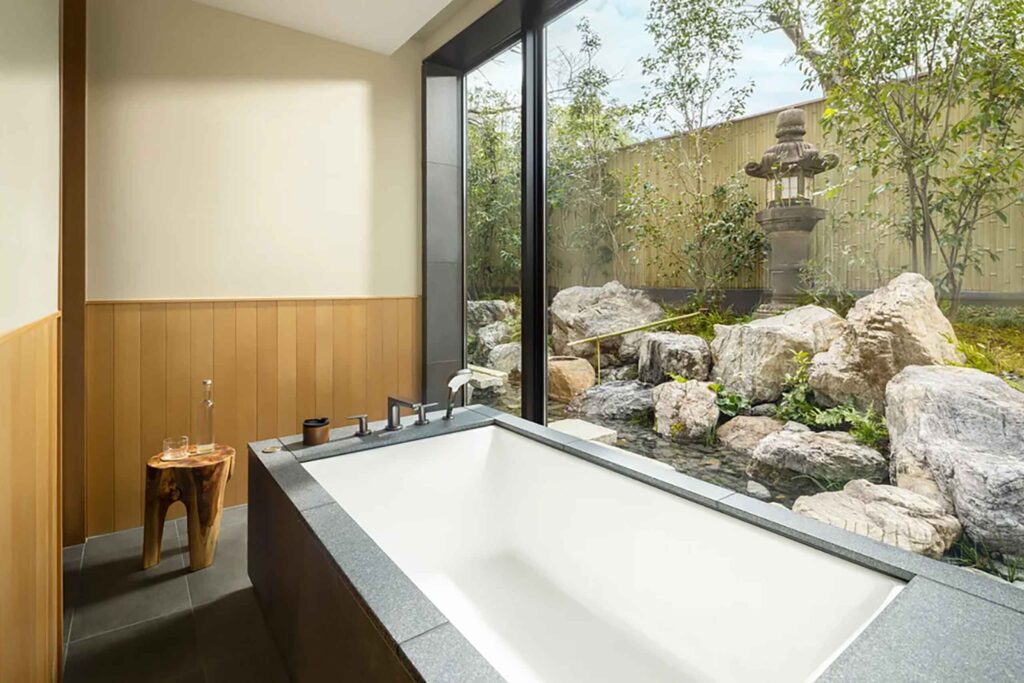

| Perfect for | Fly into | Right on time |
| The Culturalist | KIX / ITM | GMT +9 |
| While you’re Out There |
| For an unforgettable, bookable experience just a seven-minute stroll from Six Senses Kyoto, reserve a private Ikebana lesson at the legendary Ikenobō Kaikan on Shinkyōgoku Street. Founded over six centuries ago as part of the Rokkaku-dō temple, Ikenobō is the birthplace of Kyoto’s most venerable flower-arranging school. In a sunlit tatami room overlooking a tranquil moss garden, you’ll be guided one-on-one by a Grand Master through the rhythmic craft of shoka or nageire styles. Using seasonal blooms – cherry blossoms in spring, pine and eucalyptus in winter – you’ll learn how each stem’s line and space evoke seasons, emotions and harmony. By the end of this profound encounter with Kyoto’s timeless artistry, you’ll take home your own elegant arrangement in a handcrafted bronze vase and a new appreciation for the profound poetry hidden in a single flower. |
There’s another bar on the hotel’s rooftop, and then another that really caught our attention: the Alchemy Bar, tucked away in one of the hotel’s most quietly magical corners, and not just because of the flickering candlelight or the whiff of yuzu and hinoki wood in the air. This isn’t your typical “sip a cocktail and gaze wistfully at a sunset” kind of bar that you might find at other Six Senses. In this venue, self-care met sacred ritual, and we became at once both guest and apothecary. Part workshop, part spa-lab, part modern-day spellcasting – the Alchemy Bar is a signature Six Senses wellness experience, but Kyoto’s version draws deeply from Japan’s centuries-old traditions of natural healing, seasonal sensibility and meticulous craftsmanship.
We got to create our own bespoke body scrubs, balms, masks and oils using local, organic and often edible ingredients – matcha, rice bran, cherry blossom essence, shiso leaf, yuzu and black sesame. Everything is laid out beautifully in ceramic jars like a minimalist tea ceremony that meets a Lush store, curated by Marie Kondo.
Guided by one of the in-house alchemy “baristas”, the experience began with a chat about how we were feeling – emotionally, physically, and spiritually. Jetlagged? Tight shoulders? If we wanted to feel more grounded or more energised? There’s a potion for that. Or rather, we made a potion for that.
We also learnt about the healing properties of Japanese botanicals and left with something that’s both personally meaningful and pretty. And of course, true to the hotel’s ethos, everything is sustainably sourced, plastic-free, and housed in reusable glass pots or beeswax wraps. Naturally!
But in perhaps the most Kyoto-esque gesture of all, Six Senses Kyoto partners with Tenkhotou, a family-run incense atelier usually reserved for temple collaborations. The mother-daughter duo led an incense-making workshop where we crafted our own scent pouches to take home as a souvenir, a meditative experience far more rewarding than buying another fridge magnet. Other such experiences include an invitation to paint beautiful, old Japanese fans using dyes made from powdered food scraps, an artistic expression that ties into the hotel’s ethos of sustainability and upcycling, not to mention playfulness, with a nod to Heian-era courtly crafts.
Even the hotel’s herb garden has a backstory: once a shrine to a general, now a biodynamic Eden of edible foliage. And the empty plot behind the hotel? That was the former home of a nobleman who had once commissioned Japan’s tallest Buddha statue for the pilgrimage route to Kiyomizu Temple nearby.
If storytelling is the heart of Six Senses Kyoto, sustainability is its soul. A small percentage of the hotel’s revenue goes to local NGOs, particularly those focusing on forest conservation. Dining at Six Senses Kyoto is a culinary homage to time and regenerative food practices. The menu cycles through Japan’s 24 micro-seasons, changing every two weeks to showcase what’s fresh, foraged, and fabulous.
And of course, true to Six Senses, known for its wellness offerings, is the Six Senses Kyoto spa. And sublime it was – a take on a Kyoto-zen-meets-tech-savvy-scientist. Try the Biohack Recovery if you’ve spent too long attempting to walk the Philosopher’s Path in shoes that should have stayed in the suitcase. Then there’s the Watsu pool, the only one in Kyoto and just the second in Japan. Imagine being rocked gently in warm water while contemplating the impermanence of cherry blossoms. It’s as surreal as it sounds.
Six Senses Kyoto may not be your traditional Six Senses. There are no barefoot butlers, thatched rooves or plunge pools overlooking the jungle. Instead, though, there is a story, a soul, and a startling sense of place.
The hotel fully represents the city it’s in, and more holistically Japan, seen through a prism of artistry, heritage and a dash of whimsy. It’s a place where frogs and foxes commune with incense makers and poets. Where design tells a tale and every tile matters. And while we took a little time to settle into its rhythm – to find the plot, if you will – when we did, and its story unfolded, it was utterly captivating. So much so, that it felt almost criminal to leave the hotel, except for the small matter of all of Kyoto waiting outside.
Photography courtesy of Six Senses Hotels, Resorts & Spas


